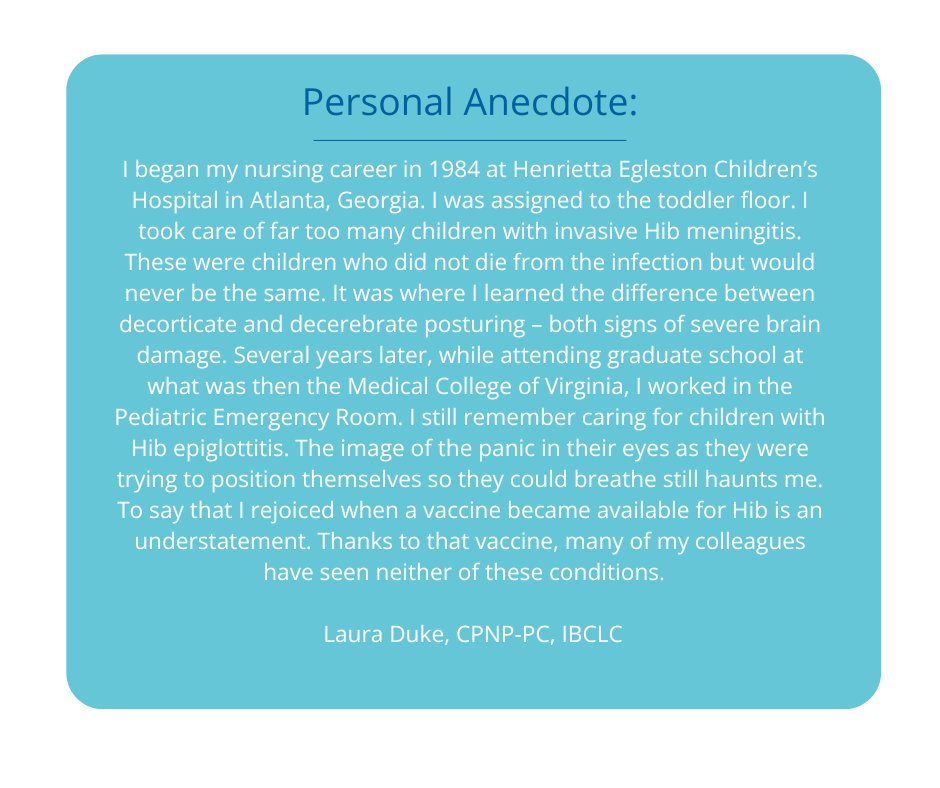What is Hib?
Haemophilus influenzae type B, commonly known as Hib, is a polysaccharide (i.e. sugar)-coated strain of a coccobacillus (hybrid of spherical/coccus and rod/bacillus shapes) known as Haemophilus influenzae or H.influenzae. It is a bacterium unlike influenza, which is a virus. It was first described in 1893 during an influenza pandemic when it was incorrectly identified as the causative organism. This is why when the bacteria was named they included the word influenza. H.influenzae comes in encapsulated (i.e. coated) and unencapsulated strains. There are 6 encapsulated strains named a, b, c, d, e and f. In the past Hib caused 95% of all cases of invasive H.influenzae disease.
Invasive disease means an infection that invades a normally sterile area such as the bloodstream or the covering of the brain (i.e. meninges). Hib is most notorious for causing meningitis (an infection of the lining of the brain) and epiglottitis (an infection that causes swelling of a tissue that sits on top of the windpipe.) It can also cause pneumonia, blood stream infections, joint infections, cellulitis, ear infections and pericarditis, infection of the sac around the heart. Less commonly it can lead to gangrene and/or serious infections of the heart valves, eyes, bones and belly cavity lining.
Prior to the 1990s, Hib was the leading cause of meningitis in children under 5 years of age. 50% to 65% of invasive Hib disease was Hib meningitis. Children with meningitis present with fever, stiff neck and drowsiness. They may also have bulging soft spots on their skulls, poor feeding, vomiting, lethargy or seizures. Their symptoms can progress quickly to coma and even death. Hib meningitis has a mortality rate of 3% – 6%. Of children who survive the illness, 30% may be left deaf, blind, permanently paralyzed or mentally impaired.
In the past, 17% of invasive Hib was epiglottitis. Epiglottitis is particularly frightening. Children with this illness present with drooling and difficulty swallowing. Their epiglottis (i.e. cartilage that covers our windpipe when we swallow to keep food and drink out of our lungs) is swollen and can progress quickly to completely block their airway. They are often anxious and prefer to sit up or hold their head in a sniffing position to keep their airway open. They have to be managed carefully to keep them calm until a specialized team can take steps to protect their airway as it can close very quickly.
How is Hib spread?
Hib is spread through contact with respiratory secretions. It is usually spread person to person by breathing in respiratory droplets. Newborns can contract Hib during birth through aspiration of amniotic fluid or contact with genital secretions. Before the introduction of this vaccine, the main source of Hib was young infants and toddlers as they may carry the organism in their respiratory tract and remain asymptomatic.
How common was Hib prior to the vaccine?
Prior to the development of the vaccine, H.Influenza was the leading cause of bacterial meningitis and other invasive bacterial disease in children under 5 years of age. Two thirds of these cases occured in children under 18 months of age. It is estimated that in children younger than 5 years, one in 200 developed invasive HIB disease prior to the vaccine. 20,000 children a year suffered from invasive HIB disease and nearly 1000 of them died. Most children acquired immunity by age 5 or 6.
When and how was the Hib vaccine developed?
In 1985, the first Hib vaccine was licensed for use in the United States. It was made from the polysaccharide coating of the bacteria. It was found not to produce a robust response in children under 2 years of age and repeated doses did not boost the antibody titer. In 1987, the first Hib conjugate vaccine was developed. By chemically bonding the polysaccharide to a more effective protein carrier, the conjugate vaccine was found to be more effective particularly in young children; repeated doses also boosted immunity.
When do children receive the Hib vaccine?
Infants receive the Hib vaccine beginning at 2 months. Several formulations are available and it is given in a 3 or 4 dose series with the last dose being completed at 15 months of age. Children from 15 to 59 months who have not previously been vaccinated get one dose. After 5 years of age the vaccination is recommended in unvaccinated people who have HIV, immune deficiency, early component complement deficiency, no spleen, or are on certain medications.
What are possible side effects of the Hib vaccine?
Any vaccine, or medication for that matter, have the very rare risk of an unpredictable serious allergic reaction such as anaphylaxis. In most children, Hib vaccination causes no side effects. Some may have a mild fever or slight reaction at the injection site such as redness, warmth or swelling. These reactions usually resolve within 72 hours.
What impact has the Hib vaccine had on the incidence of Hib invasive disease around the world?
Routine Hib vaccination began for children in 1987 and infants in 1990. Since that time the rate of invasive H.influenzae type B disease has decreased by 99%.
If invasive Hib infections have decreased by 99%, why does my child need to get a Hib vaccine?
Unfortunately, unlike the polio vaccine, vaccination against Hib can’t eliminate circulation of the germ. The dramatic decrease in invasive Hib disease is purely because of vaccination efforts. To continue protecting children from this life-altering and/or life-threatening infection, vaccination remains our best tool. We are fortunate to have such an effective tool.

References:
2024. “Haemophilus influenzae infections. Red Book: 2024-2027 Report of the Committee on Infectious Diseases, Committee on Infectious Diseases, American Academy of Pediatrics, David W. Kimberlin, MD, FAAP, Ritu Banerjee, MD, PhD, FAAP, Elizabeth D. Barnett, MD, FAAP, Ruth Lynfield, MD, FAAP, Mark H. Sawyer, MD, FAAP.
https://www.cdc.gov/hi-disease/hcp/clinicians/index.html
https://www.cdc.gov/hi-disease/php/surveillance/index.html
https://www.en.wikipedia.org/wiki/Haemophilus_influenzae
https://www.immunize.org/Haemophilus-influenza-type-b(Hib)-Questions-and-answers
https://www.who.int/europe/news-room/fact-sheets/item/haemophilus-influenzae-type-b-(hib)
